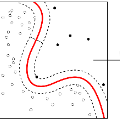This paper proposes an unsupervised anomaly detection technique for image-based plant disease diagnosis. The construction of large and publicly available datasets containing labeled images of healthy and diseased crop plants led to growing interest in computer vision techniques for automatic plant disease diagnosis. Although supervised image classifiers based on deep learning can be a powerful tool for plant disease diagnosis, they require a huge amount of labeled data. The data mining technique of anomaly detection includes unsupervised approaches that do not require rare samples for training classifiers. We propose an unsupervised anomaly detection technique for image-based plant disease diagnosis that is based on the reconstructability of colors; a deep encoder-decoder network trained to reconstruct the colors of \textit{healthy} plant images should fail to reconstruct colors of symptomatic regions. Our proposed method includes a new image-based framework for plant disease detection that utilizes a conditional adversarial network called pix2pix and a new anomaly score based on CIEDE2000 color difference. Experiments with PlantVillage dataset demonstrated the superiority of our proposed method compared to an existing anomaly detector at identifying diseased crop images in terms of accuracy, interpretability and computational efficiency.
翻译:本文建议对基于图像的植物疾病诊断采用一种不受监督的异常检测技术; 建造大型和公开的数据集,其中含有健康疾病作物和疾病作物的标签图像,使人们对计算机视觉技术的自动植物疾病诊断越来越感兴趣; 尽管基于深层学习的受监督的图像分类可成为植物疾病诊断的有力工具,但它们需要大量标签数据。 异常检测的数据挖掘技术包括一种不需要为培训分类师提供稀有样本的不受监督的异常检测技术。 我们提出了一种基于颜色可重建的基于图像的植物疾病诊断的不受监督的异常检测技术; 一个受过训练的深层编码器破坏器网络,以重建\ textit{healthy} 植物图像的颜色,不应再重建症状区域的颜色。 我们提议的方法包括一个新的基于图像的植物疾病检测框架,利用一个称为pix2pix的有条件的对抗网络和基于CEEEE2000色差异的新的异常分。 与PlanVillage的实验表明,在确定准确性、可解释性和计算功能方面的疾病作物图象方面,我们建议的方法优于现有的异常检测器。




